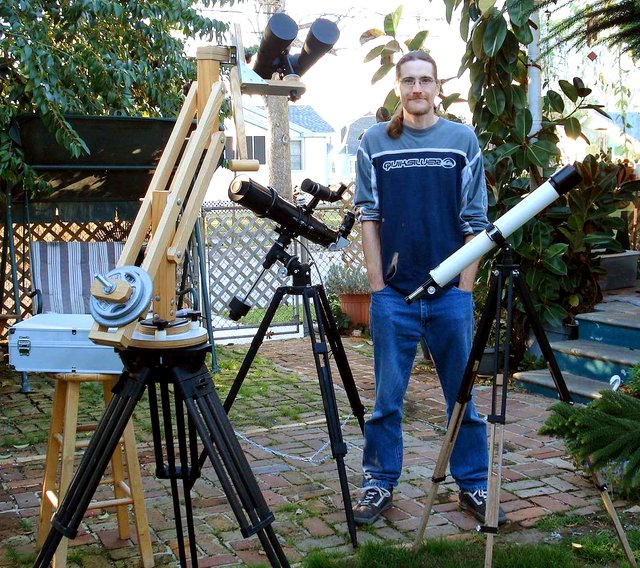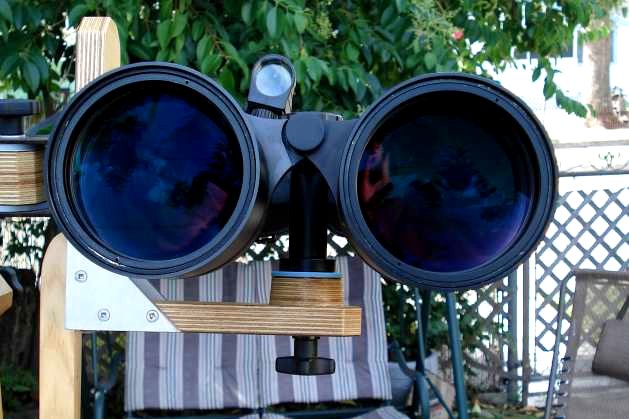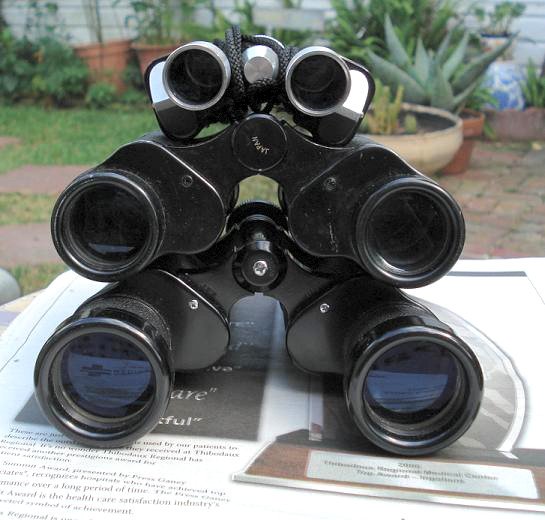A Prolific Winter Night of Stargazing with 100mm Skymaster
During the course of a 6-7 hour observing session, I bagged 20 Deep Sky Objects and 2 planets. Here are the details and notes.
PART ONE
After a few decently clear nights that I had to pass on (getting up for work early tends to dampen the previous night's observing spirit), I finally have a chance tonight to get some quality observing in.
To block out all the extra stray light making it's way into my backyard, I erected my blackout blinds. I rarely use more than one, but tonight I decided to break out the whole lot and get some quality darkness around my setup. Approx. 8'x8' of black bedsheet stretched between sturdy poles and anchored to the ground. I put these facing West towards the worst of the light trespass and towards the North to block some offending rays peeking through the cracks in my privacy fence. 25x100mm Skymaster binocular on the Tiffen Magnum tripod facing north. Planisphere and 8x42 boid glasses nearby. I start out by hitting some easy favorites.
NGC 457 : The Nazgul Cluster (or E.T. Cluster as most call it). Last time out I counted 13 stars. With some determined averted vision I confirmed a 14th and suspected a 15th this time around. I'm pretty confident of this count as the cluster is rather well defined and I have viewed it many times previously through every instrument I have. Could a field star or two creep into the count? Maybe. Or I may have shorted myself a star or two, because I am not sure where the outstretched "arms" of the Nazgul end, so I decided to be conservative and stop counting as the arms got rather long.
NGC 869 and NGC 884 : The Double Cluster in Perseus. A must see for anyone in the neighborhood.
Stock 2 : Not the most impressive object when compared to the more high-profile neighbors, but you might as well stop by for a peek while in the vicinity.
Alpha Persei : One cannot begin to fit this sprawling cluster of stars into the restrictive FOV of a 25x100 binocular. It's nice to just slowly pan around the area of Mirfak and take in all the nice aggregations of stars. A few yellows here and there amongst the whites. The 8x42mm Japanese Bushnell provides a nice view as well. Most of the cluster fits in the FOV, but the population is more sparse due to the compartively-feeble reach of the 8x binos. For me to attempt a star count on the object would be pure folly as even the scientists are unsure of exactly how many stars are bonafide members of this association.
M31 : The fickle Andromeda Galaxy. By now, it was directly at the zenith. I decided to bag it and add it to the evening's catch. WRONG. Viewing at the zenith is uncomfortable to say the least and I had unexpected difficulty locating M31 tonight. Even at the zenith, the sky is noticeably brighter than usual (did not attempt a NELM estimate) and I have been contending with transient high-altitude, patchy clouds tonight. These happened to stray though the region of M31 during my search. After a few casual minutes, my neck really started to hurt from the contortionist game. I began to get frustrated and started sweeping the binos around in broad swaths trying to nail down the usually-easy galaxy. Finally, with my neck screaming in protest, I gave up. Failure. Oh, well. To console myself I move to one of my favorites.
M45 : Faithful Pleiades. Always a pleasure. I lingered on this one for a while after my torturous ordeal to find M31. One of the most striking objects in the sky. A literal explosion of glittering jewels in the FOV. One glimpse of M45 through a 100mm binocular will spoil you for life on anything smaller. Sure, overall context is lost without the surrounding sky, but wow......again, wow.
Mars : About the same every time I look at it, only now it is getting smaller and smaller. A tiny dot of a disc with generous flaring and a bit of CA. This is one target that accentuates the flaws of cheap optics. Unlike M45 which is very forgiving, Mars is a cruel master. No detail to be seen, of course. Nice ruddy color though.
M45 : I already mentioned M45? TOUGH. I like it, so I revisit it again after getting snookered by Mars. Always a nice consolation prize.
By now, a more serious, thicker, and widespread scattering of clouds started to roll in. Orion was rising in the East, but partially obscured by clouds and skyglow. I decided to come inside, have a breather, write this report, and then go back outside for more. I think I hear Orion calling me.
PART TWO
I just got back in for a second break. The objectives were starting to dew up, so I brought the binoculars back in to absorb some more heat and discharge their ill-gotten cargo of condensation.
A few words about the sky conditions tonight.
Partly cloudy but with very good transparency between the clouds. Seeing is bad though. A fair amount of twinkling stars and I had trouble maintaining a clean focus on some objects. I could resolve all four stars of the Trapezium in M42, but only for a few moments at a time. At times, they became a twinkling messy mass of confusing points. I get the feeling that tonight is one of those nights that would be very frustrating for any sort of high-magnification observing. Score one more for binoculars over scopes!
I would rate seeing on a 1-5 scale (5 being best, 1 being worst) as a 2.
Ok, briefly....I swept up a whole heap of easy targets in the big bins during this session. I purposely took only my planisphere and left the charts inside. I decided to nail as many targets as I could by memory alone...and the red-dot finder is a BIG help to a novice like myself.
M42 : Nice views with averted vision. Could see all 4 main stars of the Trap with some difficulty (refer to seeing above). No hint of color. Big bright 100mm image - I love it and eat it up. Even on nights of marginal seeing, the hungry 100mm objectives gobble up this nebula.
M43 : M42's less-impressive little brother. Imagine the pressure this kid must feel trying to live up to his bigger brother's reputation. Mighty big shoes to fill.
Hyades : Always reminds me of a big "radiation" symbol or "biohazard" symbol of some kind.
NGC 1981 : Nice open cluster in a packed star field. Attempting a count would be futile.
Alnitak : There are five easy binocular doubles scattered around the close vicinity of this star. I'd guesstimate within a 3° radius.
Mintaka : Split this star into a double. Never really noticed it was a double before. Sometimes you just gotta stop and smell the roses. So many wonderful distractions in this area, that I never noticed Mintaka's small companion.
Orion's Belt : Reminds me of Alpha Persei but bigger and more crowded. I can spend a great deal of time just casually sweeping this area. And I do. I often wonder which of the Old Ones are staring back at me. Isn't it from Orion's Belt that Lovecraft's Old Ones hail from? I forget at the moment. But that's the kind of distracting stuff I think about while observing. Maybe it's the Kentucky Bourbon?
M36, M37, M38 : I used to have trouble defining this region and picking out the clusters. Now they are old friends. Not much going on here, just a few Messier Alumni hanging around in the Chariot killing time.
NGC 2264 : One of my trouble-maker clusters. In the recent past I miscounted this cluster, grossly. So this time around I made no such silly attempt to count the members of this wonderful object. Nice to sit and stare at though. One of the evening's dark-horse pleasures.
Horsehead Nebula : Finally captured this elusive object with my 8x42 bird glasses......nice view, fully defined horse head surrounded by fierce red nebulosity.....JUST KIDDING! Not a chance in the world. I just thought I would mention it because the phrase "dark horse" above made me think of it.
M35 : Another nice cluster, easy to find.
M41 : Another easy catch, one of the first (if not the first) Messier object I ever captured. The brightest star in the sky is right next to it, can't be missed. Off to one side slightly and then down a bit.
Well, I think I'll go out for round three and see if the clouds will be kind. I think this time I'll consult Starry Nights and bring a chart or two outside.
PART THREE
I went back out for a final session. The sky had cleared up considerably, the seeing improved somewhat, and decided to knock down some more targets.
Saturn : Did I just see two moons? Two stellar dots were seen in close proximity to Saturn. I assume one may have been Titan. Not sure whether these were Moons or field stars. Saturn's rings were orientated from a One O'clock to Seven O'clock position.
M44 : A beautiful cluster only a hop skip and a jump away from Saturn. It was still low on the horizon and bathed in skyglow, so the view of the Beehive was not as good as usual.
M50 : I swung around and bagged this cluster again. Shoot a line straight down from Betelgeuse and another line straight left from Sirius - the point where these lines meet is M50. (approximately)
M79 : Just to inflate my count for the evening, I thought I would re-bag this easy glob. But the sky was very bright at this time and this faint object would not appear. It was washed out by the skyglow. I was gazing right at the spot where it resides, but no-one was home.
M42 : Again. After another failure trying to find M79, I decided to console myself with an extended stroll arounf the Orion Complex again. By now, Orion was riding the meridian and was perched high in southern sky near the zenith. I turned to the Trap in M42 and saw all four main components with ease (the seeing has calmed down). Lots of nebulosity visible.
M43 : This was the most visible I have ever seen M43. It's still nothing when compared to it's big brother right next door, but it's still a nice complement. Usually M43 is a barely-there ghost for me, tonight it was readily apparent.
Pyxis-Hydra Highway : Took a slow and casual stroll though some new space. I had never before scanned this area. I didn't have my charts on me, so I did not what to expect. I would have also scanned Puppis, but a large tree was blocking my view. I didn't bag any new objects here, but enjoyed myself. When I say "Pyxis-Hydra Highway", I am referring to the "empty space" on the charts between these two regions.
M67 : I bagged this new object however. Not exactly the most striking cluster to look at. I had to dash inside with one eye closed and consult Starry Nights to make sure that I had actually located M67. Not too hard to find, it's hanging around in close proximity to M44 and Saturn.
Before I decided to pack it in for the night, I noticed that M1 "The Elusive Crab" was parked right on the darkest part of the zenith. For kicks I looked at M45 naked eye and counted 6 stars and suspected a 7th. This is the best naked-eye view of M45 I have had and it too was riding very near the zenith, so I figured I had a slim shot of finally bagging M1. With low expectations, I turned around, elevated my center shaft, pointed the big binos straight up, and went into my contortionist game to get under the eyepieces. I slowly scanned and lingered on the M1 target area......failure again. This is the darkest part of my local sky and a moonless (at the time) night. I know realize that I will never capture M1 from my backyard without a huge stroke of luck - such as a widespread power outage on a moonless night. This object is simply to faint to contrast against my washed-out skies.
I was tempted to stay outside, but the temps were starting to drop and I was getting tired. So with a final peek at M42, I called it an evening.
Thanks for reading and keep looking up! Clear dark skies to you. :)
MikeG (Galactic Stone)
See my other astronomy and science blogs - https://steemit.com/@galacticstone
Image credits : All images by me, MikeG (Galactic Stone)
Note : an earlier version of this article by me appeared on the Cloudy Nights astronomy forum.



upvote for me please? https://steemit.com/news/@bible.com/6h36cq